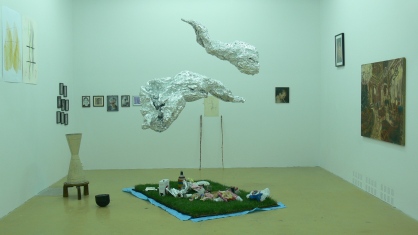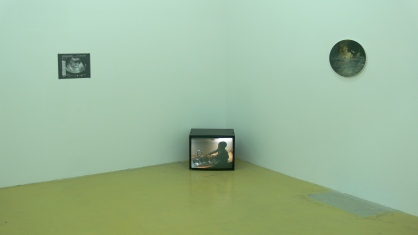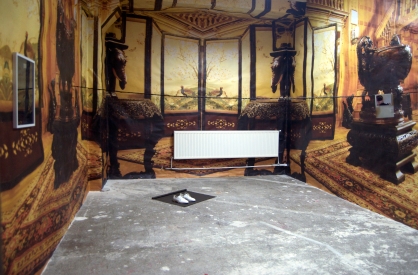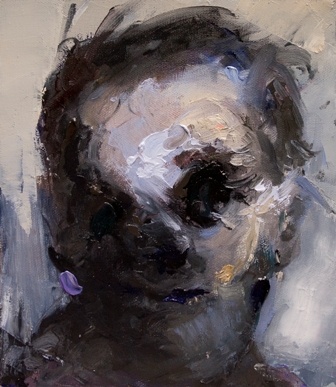Three Shifts at the Paintbrushes Factory
June 1, 2011
A series of exhibitions opened at the Paintbrushes Factory in Cluj on the evening of May the 27th, 2011. Several times before, this type of concentration of events proved successful, both in terms of artistic content and of public’s reaction and participation. This time, a sort of togetherness was suggested by the very fact that various events were placed under the unique conceptual umbrella of a programme called Three Shifts at the Paintbrushes Factory (besides the six exhibition openings, the programme included a conference, a book launch and a theatre performance). However, at least as far as the exhibitions were concerned, one must remark that this latest big event at the Cluj art centre wasn’t as forceful and as rich as one might have expected – given its rather massive scale – and that a sort of post – Vienna art fair, pre – TIFF and pre – summer vacation slight relaxation could be detected.
Nevertheless, diversity and meaningfulness still characterized, on the whole, the exhibitions opened on the above mentioned evening. One of the most rewarding and puzzling at the same time was The May Salon at the Plan B Gallery, which featured some of the well known artists of the gallery, as well as some of their friends as guest artists. Thus, the show comprised works by Ioana Batranu, Corneliu Brudascu, Rudolf Bone, Mircea Cantor, Ion Grigorescu, Victor Man and Anna Bella Papp, Ciprian Muresan and Cristian Opris, Miklos Onucsan, Cristi Pogacean, Eugenia Pop, Serban Savu and Gabriela Vanga.
The very appropriation of the word “Salon” is conceptually challenging and problematic. Does its use mean that Plan B Gallery is assuming the position of an authoritative institution, claiming the right to act like a jury that decides what is and what is not relevant in Romanian contemporary art? Or is it used in a rather ironical way, especially towards what the official salons represented during the communist era inRomania? Are we dealing here with self irony or with sheer hubris wearing the mask of loose playfulness? The show doesn’t quite clarify these issues, and the ambiguity it leaves us with is significantly and wittily perverse.
The exhibition itself actually looked rather uneven from the point of view of the quality and the poignancy of the displayed works, appearing like a casual “gathering of friends” from various generations, unpretentiously showing artworks to each other and to the public. The apparent democratic selection replaced a stronger curatorial concept (though the show did presumably have a curator, namely Mircea Cantor). Casualness was emphasized by the fact that one of the artists that were announced to take part in the show, namely Adrian Ghenie, was actually absent from it – a surprising organizing slip, uncharacteristic of the careful planning of the shows that Plan B usually deploys.
Bringing together some very good artists, the show inevitably presented the public with some poignant and forceful works. The ellipsoid painting of Brudascu, a gestural representation of a young boy on the verge of being sucked into some swirling waves is nothing less than a straightforward and emotionally charged demonstration of painterly mastery. Cristian Opris’ engravings of faces on banknotes are delightfully realistic and subtly ironic. Ioana Batranu’s painting of a salon – like interior is a feast of colours, the painterly rendering of the space providing it with an intensely surreal, engagingly dreamlike appearance. Mircea Cantor’s very short video, showing a child who tries to cut with a scissor the stream of tap water flowing in front of him is meaningful in a very simple way and metaphorically bold: a complete and telling artwork.
Rudolf Bone’s picnic performance / installation (a rectangular lawn, some food and drinks waiting for the spectators to join the artist for the ad hoc picnic and two clouds, childishly made out of tinfoil, above the whole scene) was certainly the main attraction of the show, although, if one sets aside its interactivity and its mildly ironic playfulness, it really hasn’t got much to offer. Finally, other works were not so convincing, as some contributions were rather dull (Gabriela Vanga’s for example). In a bizarre manner, Man and Papp’s installation was concomitantly fascinating and bordering pretentious incomprehensibility.
Laika Gallery presented a film by Mircea Gherghinescu about the (in)famous “House of the People” erected at Ceausescu’s orders in Bucharest. Titled La Pyramide du Fanfaron, the film is truly impressive, as it is a tensed mixture of documentary, satire and visual lyricism. Mircea Gherghinescu, aged 77, is one of the most esteemed Romanian television professionals and professor at the Bucharest Institute of Cinematographic Art. His film, about thirty minutes long, is, first of all, a study and a lesson about filmic image. Close-ups and broad views alternate in a finely orchestrated rhythm, composing what can be described as a portrait of a building and an epitomized description of an era.
Filmed in 1992, La Pyramide du Fanfaron reveals both the megalomaniacal impulse that led to the construction of the “House of the People” and the terrible fascination it can induce, in other words, it circumscribes both utopia and the sordid realities perversely masked by it. Images of the monumental facades are rapidly followed by those of wrecked, unfinished sections of the huge building; the luxury of the details of interior design is paired by the derisory and uncanny images of lonely sentinels. A subtle irony can at some points be perceived, as it is the case with the images of ashtrays placed in the middle of such large tables that it would have made it almost impossible for the sitters to actually reach them.
If I were to point out a weakness of Laika’s show, it would be the fact that Gherghinescu’s beautiful film lacked context. It is always difficult to construct an art show with just one work, even if, or especially when the work consists in a video screening. Other works of Gherghinescu or works by other artists that could have constituted points of reference might have added even more energy to the show. However, La Pyramide du Fanfaron was a truly compelling exhibition, able to generate both intense aesthetic experience and acute reflection.
Peles Empire is an ongoing project pursued by two young British artists (pardon the involuntary cliché), namely Katharina Stoever and Barbara Wolff, that started off in 2005 in Frankfurt. The two artists have reproduced, in printed versions, several rooms in the Romanian Peles Castle in various venues (in Frankfurt, London, Los Angeles, Antwerp, Basel, Bremen and, recently, Cluj) and invited artists to insert their artistic interventions in these particular environments. Currently, Peles Empire runs two such transformed spaces, one inLondon and the other one at the Paintbrushes Factory. The project in itself is remarkably coherent and uncannily appealing, intriguing in its arbitrariness as probably any challenging artistic endeavour is supposed to be and charming in its ambiguous, somewhat conceptually loose, though not entirely naïve approach of (art) history and of ideas such as reproduction, eclecticism and transformative cultural action.
Karl Orton’s Those Wild Days Were Dogs is the most recent intervention in the Cluj venue of the Peles Empire. Orton is aLondon andRotterdam based artist that has collaborated with the Empire before and possesses what seems to be a formative background in collaborations with the fashion industry. His intervention in the Cluj venue is a mix of minimalist elegance and baroque glamour, with a black leather – like rope stretched between two opposite walls, from which a piece of paper with a photo portrait of the (masked) artist is hanging and with a pair of white shoes placed on the floor, fitted with small mirrors inside. The objects function both as ambiguous signifiers of cultural constructs and as idiosyncratic items referring to a highly personal and thus mostly incomprehensible narrative. In the room covered with the printed reproduction of the lavish Peles Palace chamber, Orton’s intervention almost evanesces, yet the objects he places their still retain a haunting quality, which actually is the most prominent strength of his installation (one might be tempted to say the only strength, but I wouldn’t go so far, though).
Aline Cautis’ solo show at Sabot gallery, titled With, for and against each other, is the result of honest and somewhat courageous artistic research, which focuses on the medium of painting and its contemporary, namely post – avant-garde, status. According to the organizers of the exhibition, “her paintings attempt to move forward, add, subtract, move back, gesture, articulate and confuse all, reach out, reach in, make sense of contradiction and navigate across practices”. The paintings, most of them juxtaposed in two vertical, rather irregularly, yet vaguely monumentally shaped panels, were joined in the exhibition by two almost lyrical, vividly colourful video pieces.
 Unfortunately, earnestness and intellectual curiosity do not automatically grant quality to an artistic project. In the case of Aline Cautis, although it is true that her works “articulate and confuse all, reach out, reach in”, they do not actually “make sense of contradiction”. They rather embrace it in a far from compelling way. Although her painted, empty picture frames are eye catchy and one or two of the individually displayed paintings don’t lack painterly qualities, the overall impression one is left with after viewing the show is that of unfruitful confusion. All in all, the (otherwise definitely gifted) young artist kind of proved that there is a thin line that separates questioning the medium of painting and misusing it.
Unfortunately, earnestness and intellectual curiosity do not automatically grant quality to an artistic project. In the case of Aline Cautis, although it is true that her works “articulate and confuse all, reach out, reach in”, they do not actually “make sense of contradiction”. They rather embrace it in a far from compelling way. Although her painted, empty picture frames are eye catchy and one or two of the individually displayed paintings don’t lack painterly qualities, the overall impression one is left with after viewing the show is that of unfruitful confusion. All in all, the (otherwise definitely gifted) young artist kind of proved that there is a thin line that separates questioning the medium of painting and misusing it.
In her photo studio at the Paintbrushes Factory, Irina Dumitrascu organized her photo solo show, titled Fly with Me. There were about a dozen well done photographs: well composed, well printed, powerfully modelled by means of chiaroscuro images of the artist’s friends and (former) colleagues, jumping or somehow hovering in an undefined space. That was pretty much all that was to see and understand. The photos were displayed rather high on the wall, one may presume, in order to (redundantly, I would say) emphasize the idea of flight, also present in the title. The exhibition certainly didn’t urge me to fly anywhere and did not elevate me in any way, for that matter, but I truly hope that other visitors were more impressed than me.
Finally, Portraits was the first solo exhibition of the young Cluj based painter Belenyi Szabolcs, hosted by Bazis gallery, a venue which is beginning to build itself a profile as a platform for more or less expressionistic artistic endeavours, presumably highly personal and heartfelt, somehow indifferent towards trends, yet somewhat lacking, at times, serious reflection on the deployed artistic instruments. Being involved in curating the show, I can only reassert here what I’ve already written in the critical text accompanying it.
Thus, I believe that romanticist nostalgias and youthful hubris can be detected in the recent works of Belenyi, as his painting refuses to use both the traditional life model and the photographic images as starting point. Belenyi believes in the creative power of extreme subjectivity, in the expressive forcefulness of the medium of painting and in art’s vocation to approach the grandiose topic of the human soul and individuality. As cliché, obsolete or utopian that might sound or even be, his painterly endeavours are nevertheless almost heroic testimonies of an artistic boldness which is adequately matched by his technical mastery of the medium.
The figures he depicts always look tormented and troubled; they appear as victimized silhouettes stemming from some dark, awkward reveries. Belenyi Szabolcs literally paints people as he remembers them, and he always seems to remember them as ghosts.
The Paintbrushes Factory is approaching two years of existence. The art centre here has definitely grown, by that meaning that both the number of art spaces within and the relevance or the art projects undertaken here have increased. Its future however depends on the will and ability of the Factory’s people, so to speak, to keep investing equally effort, seriousness and wit in their endeavours. I, for one, am hopeful.




May 9, 2012 at 12:06 am
[…] https://iacobbogdan.wordpress.com/2011/06/01/three-shifts-at-the-paintbrushes-factory/ Posted on 05 8th, 2012 | no responses […]